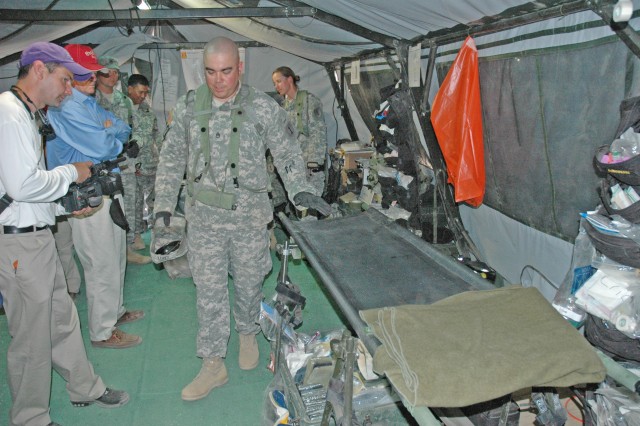
FORT IRWIN, Calif. - Units of the 4,000-Soldier 4th Infantry Brigade Combat Team are scattered over the 100,000-acre National Training Center as it heads into the middle of its final nine-day full spectrum training schedule.
During those nine days, the brigade will be applying the lessons of the previous 10 days in a wide open operation in which anything could happen. For members of the brigade, those lessons are of vital importance to their mission at NTC.
Since the brigade's last deployment during the 2007-08 surge in Iraq, which saw it in some of the most dangerous fighting to stabilize that nation, the mission has changed for its Soldiers.
Where once American forces carried the load of the fighting in unilateral operations, the new mission calls for the Iraqi army and police units to shoulder the load. That change is being carried out using a theory of, "By, With And Through" to create greater security in Iraq.
"We're asking Iraqis 'what is your plan and we're here to support you,'" said Maj. Gen. Vincent Brooks, commanding general of the 1st Infantry Division and Fort Riley. "We're teaching the Iraqis to operate as a military service under civilian control and to operate within the rules of the law."
This is a significant transformation for the Iraqis, he said, and one of importance to the Middle East. It is all part of an effort in which strategic laws for the good of the nation are more important than culture or loyalty to the party or person, he added.
"The NTC continues to get better and better," he said. "Realism is how we're able to create an environment of high-level learning for individuals and collective groups (members of the 4th IBCT).
"I think we're getting it right," said Brooks, who was at NTC in January and has seen the training scenario change since that time. "There's a lot of training going on."
NTC staff and training units receive information from Iraq and Afghanistan and will change the training at least every quarter, so that deploying units will have the most up-to-date information.
The training is completed in several segments.
The first five days the units work on Reception, Staging, Onward Movement and Integration through force generation and unit task organization, negotiation training and media interviews, establishing digital networks and integrating base defenses.
The second stage, which also lasts five days, they work on small unit training, including combined operations, coalition efforts, warrior tasks and battle drills as well as live fire training, mounted and dismounted combat patrols, personnel recovery and route clearance.
During the full spectrum training, the brigade's units use what they learned to operate in the theater of operations, including working with the civilian population, the media, insurgent and criminal elements, and combined operations.
As part of that training, NTC employees, both native Iraqis who live in the United States and play the roles of major figures, such as mayors, police chiefs and military officials in the villages, and contract employees who are employed as actors to play the roles of villagers, are used.
In addition, NTC has built a dozen realistic villages for training.
There are 10 training rotations a year at NTC, including one involving a Canadian Battle Group that is training for Afghanistan early next year, said Brig. Gen. Robert Abrams, commanding general of NTC and Fort Irwin.
Joint training is emphasized at the training center.
"We're joint in everything we do," Abrams said. The Air Force assists with unmanned vehicles and flight aircraft. There are role-speaking Iraqi-Americans. A unit from the State Department also trains and is deployed with the 4th IBCT, 1st Inf. Div.
Fort Irwin has 5,000 Soldiers on post who work in the training operation. Seventy-five percent of the Soldiers and their Families live on post, which is about 40 miles from the nearest town. The goal is to have housing on post for 100 percent of the Soldiers and their Families.
Story provided by Tom Throne of the Junction City Daily Union. He traveled with the 'Dragon' Brigade to the National Training Center.

Social Sharing